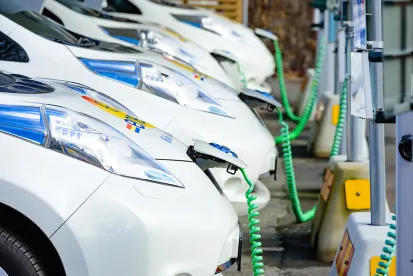There is a lot of buzz around clean technology, distributed energy resources (DERs), microgrids, and other technological innovations in the renewable energy and clean transport industries, and how these developments can contribute to solving longstanding environmental justice issues. As these innovations develop, energy markets will undergo substantial changes to which consumers and industry participants alike will need to adapt and leverage. Every other week, K&L Gates’ The Energizer will highlight emerging issues or stories relating to the use of DERs, energy storage, emerging technologies, hydrogen, and other innovations driving the energy industry forward.
FEDERAL HIGHWAY ADMINISTRATION PROPOSES MINIMUM STANDARDS AND REQUIREMENTS FOR FEDERALLY-FUNDED ELECTRIC VEHICLE CHARGING INFRASTRUCTURE
On 9 June 2022, the U.S. Department of Transportation’s Federal Highway Administration (FHWA) issued a Notice of Proposed Rulemaking (NOPR) detailing minimum standards and requirements for projects funded under the Infrastructure Investment and Jobs Act’s (IIJA’s) National Electric Vehicle Infrastructure Formula Program (NEVI Program). The IIJA was signed into law on 15 November 2021 and allocated US$ 5 billion to the NEVI Program. Those funds will be used to accelerate deployment of public electric vehicle charging infrastructure by filling gaps in the national network along designated Alternative Fuel Corridors. On 10 February 2022, the FHWA issued guidance and procedural timelines for states to propose plans explaining how they would use their respective portion of the US$ 5 billion of available funding. Each state’s plans for the first year of funding are due on 1 August 2022, and the FHWA will decide whether to approve each plan by 30 September 2022.
The recent NOPR provides a preliminary set of standards that would apply to projects funded under the NEVI Program. It would include: (1) installation, operation and maintenance; (2) interoperability; (3) traffic control device or on-premises signage; (4) data collection; (5) network connectivity; and (6) information on locations, pricing, real-time availability, and accessibility through mapping applications.
Interested stakeholders may submit public comments on the NOPR by the deadline of 22 August 2022. Once FHWA has reviewed and considered the comments, it will then determine whether to issue a final rule, including whether to adopt any revisions to the proposed standards and requirements.
DEPARTMENT OF ENERGY OFFERS FUNDING TO COMBAT CLIMATE CHANGE IMPACTS TO GRID SYSTEM
On 6 July 2022, the U.S. Department of Energy (DOE) commenced its Preventing Outages and Enhancing the Resilience of the Electric Grid formula grant program as part of the Building a Better Grid Initiative launched on January 12, 2022. The Build a Better Grid Initiative was created to resolve the impacts that climate change has on transmission systems and to increase access to affordable and reliable clean energy.
The Preventing Outages and Enhancing the Resilience of the Electric Grid formula grant program will provide US$ 459 million annually to grant recipients for a five-year period, totaling US$ 2.3 billion. The funding is to be used to reinforce and renovate existing grid infrastructure to better equip it for the disruptive effects of climate change, including wildfires, severe weather, and other natural disasters that are increasing in size, scope and frequency due to climate change.
DOE is accepting applications from States, Tribal nations, and territories between 6 July 2022 and 30 September 2022. The funding program will make awards commensurate with the White House’s Justice40 Initiative to provide 40% of benefits from climate investments to marginalized communities most impacted by climate change, pollution, and underinvestment.
COLORADO’S TRANSITION FROM COAL IS SEVERAL YEARS AHEAD OF SCHEDULE
On 1 July 2022, the Colorado Energy Office announced that the ambitious schedule the Colorado legislature set in 2019 to reduce greenhouse gas (GHG) emissions to 80% of 2005 levels by 2030 and to 90% of 2005 levels by 2050 is several years ahead of schedule. As part of the legislature’s mandate that Colorado’s two largest utilities submit utility plans to meet these goals, Xcel Energy (the single largest utility in Colorado) submitted a plan to reduce GHG emissions to 85% levels by 2030 and shutter the last coal-fired unit in the state, Comanche 3, by the close of 2031. That would be three years earlier than agreed upon in a 2021 settlement. Xcel’s plans also promise that the company will continue to make property tax payments through 2040 to support the community surrounding the decommissioned coal-fired facility. Xcel also commits to help support a clean energy transition in the Pueblo, Colorado area.
The Colorado Public Utility Commission (CPUC) has already approved a utility proposal from Tri-State Generation and Transmission Association that meets the legislature’s GHG reduction goals. CPUC Commissioners voted in June 2022 to support the early closure of Comanche 3 and are anticipated to formally approve Xcel’s plan later in July.
David Wang co-authored this article.






 />i
/>i
